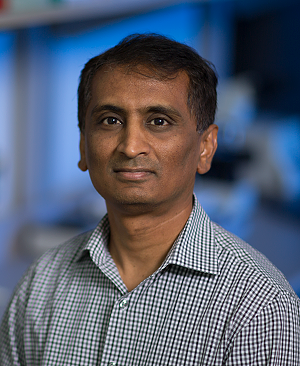
Clinical Genomics and Therapeutics Division
Dr. Kaadige is a research scientist focused on developing new targeted therapeutics for cancer and neurological disorders. At TGen, Dr. Kaadige works closely with Dr. Sharma and Dr. Soldi in the Clinical Genomics and Therapeutics Division. The team uses a combination of computational drug design, synthetic medicinal chemistry, and biology to discover small molecule inhibitors and/or activators for cancer therapy and neurological diseases. In addition, the team is also developing a cell therapy program using proprietary technologies and a comprehensive omic’s analysis. Dr. Kaadige directs the development of small molecule programs and assists with the cell therapy program.
The team is presently developing small molecule inhibitors and/or activators for targets involved in epigenetics, immune modulation, bone metastasis, and neurological diseases. Tumor genetic heterogeneity can lead to dysregulation of transcriptional programs and cause cancer cells to become highly dependent on certain regulators of gene expression. Super enhancer (SE) is one such regulator and tumor cells are known to acquire SEs at oncogenic driver genes (MYC, TERT, BCL2, GFI1, MED1, OCT4, and SOX2), activate their expression, and induce transcriptional reprogramming. Importantly, the majority of super-enhancers depend on the ability of cyclin-dependent kinase 7 (CDK7) to initiate transcription by phosphorylating the C-terminal domain of RNA Pol II. High level of CDK7 is associated with poor prognosis in breast, gastric, ovarian, pancreatic, SCLC, ATC, and AML cancers. The team has developed novel, potent, and reversible inhibitors of CDK7 that are currently undergoing preclinical testing in murine tumor models. Several other programs are at different stages of development.
Dr. Kaadige joined TGen as a Research Assistant Professor in September 2017. He received his PhD from the Wayne State University in 2003 where he studied phospholipid gene expression mechanisms under the guidance of Dr. John Lopes. He joined Huntsman Cancer Institute at the University of Utah for his post-doctoral training and worked as a Research Assistant Professor under the mentorship of Dr. Don Ayer. His research was primarily focused on cancer cell metabolism. He spent many years studying the mechanisms and signaling pathways involved in the development and progression of cancer. Prior to teaming up with Dr. Sharma, he worked at NSP as a principal scientist where he was involved in pre-clinical discovery and clinical testing of novel formulations.
SELECTED PUBLICATIONS
The novel reversible LSD1 inhibitor SP-2577 promotes anti-tumor immunity in SWItch/Sucrose-NonFermentable (SWI/SNF) complex mutated ovarian cancer. Soldi R., HalderTG., Weston A., Thode T., Drenner K., Lewis R., Kaadige MR., Srivastava S., Ampanattu SD., Rodriguez del Villar R., Lang J., Vankayalapati H., Weissman B., Trent JM., Hendricks WPD., Sharma S., (2020) PLOS ONE; In press
Metabolic reprogramming in triple-negative breast cancer through Myc suppression of TXNIP. Shen L., O’Shea JM., Kaadige MR., Cunha S., Wilde BR., Cohen AL., Welm AL., and Ayer DE., (2015) Proc Natl Acad Sci USA 112(17):5425-30.
MondoA:Mlx transcriptional activity is limited by mTOR-MondoA interaction. Kaadige MR., Yang J., Wilde BR., and Ayer DE., (2015) Mol Cell Biol 35(1):101-10.
Response of BRAF-mutant melanoma to BRAF inhibition is mediated by a network of transcriptional regulators of glycolysis. Parmenter TJ., Kleinschmidt M., Kinross KM., Bond ST., Li J., Kaadige MR., Rao A., Sheppard KE., Hugo W., Pupo GM., Pearson RB., McGee SL., Long GV., Scolyer RA., Rizos H., Lo RS., Cullinane C., Ayer DE., Ribas A., Johnstone RW., Hicks R., and McArthur GA., (2014) Cancer Discov 4(4): 423-33.
Glutamine-dependent anapleurosis dictates glucose uptake and cell growth by regulating MondoA transcriptional activity. Kaadige MR., Looper RE., Kamalanaadhan S., and Ayer DE., (2009) Proc Natl Acad Sci USA 106(35): 14878-14883.
We found 2 results matching most recent news articles for "Mohan Kaadige"